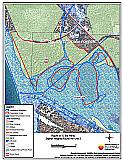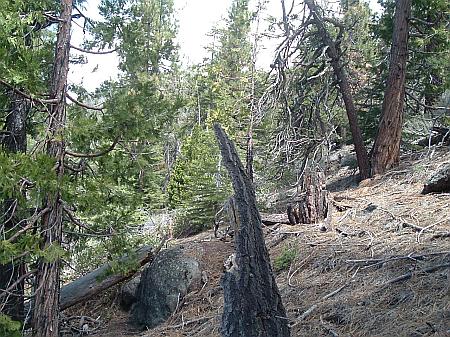Risk/Hazard Identification and Mitigation Project Worksheet
Name of Community: Elk Point/Zephyr Heights/Round Hill
Date: July, 2004
Project Title: Elk Point/Zephyr Heights/Round Hill Unit 2 - Thinning and Brush Removal
Description of Risk/Hazard: Describe in detail the risk or hazard that poses a threat to the community.
Vegetative Fuel and Topography: The Elk Point Unit 2 prescription area is characterized by an overstocked stand of second growth Jeffery pine. The understory consists of manzanita and bitterbrush. Slopes are fairly flat, all less than 30 percent.
Worst Case Scenario / Hazard: Nevada Beach Campground is located in this unit, where open campfires are allowed with heavy recreational use. A human-caused ignition from the campground on an extreme hazard day with high winds from the lake will create an uncontrollable fire moving directly at Highway 50 and the neighborhood of Round Hill.
Priority Ranking: What is the priority ranking of this risk/hazard in relation to all others identified?
Because of fuels below and on the windward side of the community, this project ranks as #5 for the TDFPD.
Location: Describe or attach a map with sufficient detail to allow accurate ground location.
Directly east of Nevada Beach. See Figure 11-5 for details.
Recommended Mitigation Measures and Scope of Work: Present prescription and work specifications in sufficient detail to facilitate procurement of bids and quotes. For hazardous fuel removal projects include estimated volumes (tons/acre) of fuel removed and disposal plan.
Remove or thin brush understory to decrease the fire intensity and reduce ladder fuels. Remove dead and down material. Spacing between remaining bushes should be 2-3 times the height of brush and in open areas near trees at least two times the height of the trees. A brush masticator or “Bull Hog” could be used throughout the area as slopes are fairly flat. Grind the brush and leave as mulch, or hand cut, pile, and burn. Use of herbicide could reduce sprouting of some species.
Thin forest stand from below, removing smaller trees and leaving larger ones to achieve the desired stocking rate of 80 to 100 square feet of basal area per acre. Whole tree skidding and chipping on landing would minimize problems from burnings.
*Prescribed fire could be used to reduce the brush understory, and desired where feasible to return fire to the landscape. It should only be applied in areas after thinning and slash pile burning are complete to maintain fire control
Evaluation of the Extent to Which Completion of This Project Will Reduce the Fire Threat:
Area has heavy recreational use, including barbeque facilities, that increases the likelihood of a human-caused ignition. Treatment in this area will help contain human-caused ignitions below the project area, keeping fire from spreading uphill and becoming uncontrollable. Implementation of the prescription will reduce the competition among residual trees, increasing forest health and decreasing tree mortality. This will reduce the amount of accumulated dead and down material contributing to the fuel loadings on the forest floor, and break up the vertical continuity of the fuels.
If all of the recommendations in this report are implemented, there is still no guarantee that a devastating wildfire will not occur in the area. However, community awareness and individual attention to fuels management on private property and fuel reduction on state, federal, and county property will help to achieve the highest level of wildfire safety possible.
Identification of Protected Species or Other Critical Resources: Describe any measures that must be taken to protect critical wildlife habitat, historic
Environmental compliance measures must be implemented before project initiation. Stream Environment Zones are located in the project area and must be protected, employing appropriate TRPA mitigation measures.
Some threatened and endangered species exist in the Tahoe Basin. Appropriate avoidance and mitigation measures should be employed during project implementation.
Compliance with cultural resource protection may also be necessary. Check with TRPA and the NVSHPO to ensure cultural resources are protected.
Post-project Rehabilitation: Present scope of work in sufficient detail to facilitate procurement of bids and quotes.
Rehabilitate any fire control lines, landings or disturbed areas. Rehabilitation will be minimal if only hand methods are used. Where soil has been disturbed, TRPA rehabilitation measures and Best Management Practices would apply. This could include reseeding or mulching areas if necessary.
Estimated Timeline:
Desirable time of year to complete:
May - October - December
Estimated time required to complete project:
2 1/2 months, plus time for burning.
Estimated Cost: Present an estimate of the total cost of project completion and the basis for the estimate presented. If the project can be subdivided into phases or various components, present an estimated cost for each.
| Thinning (mechanical): | $1800 / acre | |
| Brush mastication: | $500 / acre | |
| Prescribed fire: | $500 / acre | |
| Total - 128 acres thinning and mastication or thinning and prescribed burn | $358,400 | |
Cost for environmental compliance including cultural resource investigations and threatened and endangered species clearances may be equal to the cost of conducting the work on the ground.
Project Maintenance Requirements:
If area is treated with a brush masticator, then the area should be retreated with a brush masticator or prescribed fire within five years of treatment. If treated by prescribed fire, then repeat with prescribed fire within 10 years.
Other Considerations: Describe any other considerations that must be taken into account to successfully complete this project such as permits, clearances, approvals, etc.
- USFS Regional Approval
- TRPA Approval
- Air Quality Approval
Figure 11-5Proposed Prescription Area Elk Point/Zephyr Heights/Round Hill Unit 2 |
 |

